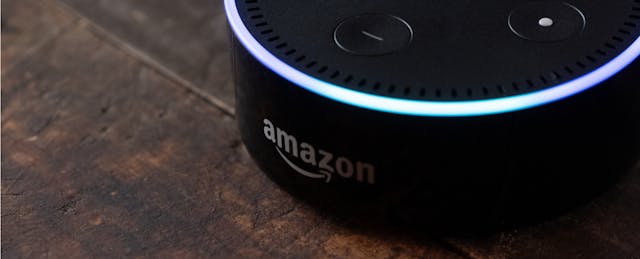Four-and-a-half years after Amazon first released Alexa, its voice-activated virtual assistant, the technology is finding its footing in education.
Across the massive, brightly colored expo hall at ISTE 2019, the annual education technology conference where companies display and demo their latest gadgets, upgrades and software, several vendors showcased the new skills they have developed for Alexa-enabled devices.
The nonprofit ACT, which is best-known for its standardized college entrance test, privately demonstrated its new skill on an Amazon Echo Dot. The ACT skill, which provides general information about the exam and can help students prepare for the test, will be available to the public this fall.

Steve Polyak, who leads the nonprofit’s research innovation development group, says ACT developed the skill after realizing they had an opportunity to reach people where they are. “This device is sitting in millions of people’s homes,” he says. “So parents and learners—their children—who are having conversations about, ‘It’s time to take the ACT’ … can ask questions” right from where the conversation is taking place.
Alexa, why should I take the ACT? Alexa, how much does it cost to take the ACT? Alexa, when is the next ACT test date? Through the skill, families can explore those questions together, Polyak says.
And when students are ready, they can begin to prepare for the test, working through all subject materials and topic areas, with videos and other tutorials available just as they are online through students’ ACT Academy accounts, Polyak says.
Kahoot, a game-based learning company with a trove of millions of educational quizzes, also announced its first Alexa skill this week. On the exhibit floor at ISTE, company officials previewed a limited version of the skill, which currently only allows users to choose among words, numbers or countries. It then provides true-or-false statements for users to answer, such as “Rio de Janeiro is the capital of Brazil. True or false.” When the skill is released to the public later this year, it will have "more functionality and categories," a spokesperson for Kahoot says, but it will not feature the millions of quizzes that the company has in its app.
Frontline Education, which makes software to help school administrators with hiring, teacher management and professional development, announced last summer that it was working with Amazon to create a voice-activated skill by early 2019. At ISTE this week the company confirmed that the skill will be available to a general audience for the 2019-2020 school year.
A representative at Frontline’s booth demonstrated the skill by asking an Echo to announce teacher absences for the day, whether any classrooms needed a substitute teacher and if there were any urgent forms to sign. The skill provides administrators with a daily report of need-to-know information, and even allows teachers to tell Alexa if they are sick and unable to make it to school that day.
These demos come just one year after an Amazon representative said—at the same conference—that Alexa should not be used in the classroom due to privacy and compliance issues.
But that warning hasn’t stopped some educators, including Alli Flowers, a technology coach at Alabama’s Mobile County Public Schools who presented at ISTE about how she has helped teachers in her district bring Alexa into their classrooms.
At ISTE last year, Flowers says she was disappointed that she did not hear about more innovative ways to use Alexa with students other than as a timer during test-taking, or for randomly calling on a student in class. “I thought, ‘There’s got to be more,’” she tells EdSurge.
Then Flowers learned how to develop her own Alexa skills using Amazon Blueprints, a website that allows users to build custom apps on the voice-enabled devices. Her passion project took off from there. Now she has taught teachers how to use it across grade levels and subjects—from kindergarten to 12th grade, from math to social studies. One of her favorite ways they use Echo Dots involves buzzers, which allow students to review test material in a game show-like environment. “It’s brand new to use it this way,” Flowers says. “It’s beautiful.”
The school has paid for the devices, which cost between $30 to $40, and there’s nearly one in every classroom, she says. In the classroom, Dots are connected to the teacher’s account, but the skills he or she creates—such as fourth grade Revolutionary War review—are shared with students’ individual accounts.
Despite worries raised and lawsuits filed over how Alexa devices might listen in on users and store and share data, Flowers says neither she nor her students’ parents are concerned about the privacy implications, because she believes the skills she develops are private and cannot be accessed by anyone else.
“Everybody loves [Alexa] and everybody wants to be able to use it in the classroom, especially when they already have one at home,” Flowers says. “Everyone is going to be using it for education” soon, she predicts.


